Assessment of the Carbon Stock in Pine Plantations in Southern Spain through ALS Data and K-Nearest Neighbor Algorithm Based Models
Abstract
1. Introduction
2. Materials and Methods
2.1. Study Area
2.2. Biomass Data
2.3. SOC Data
2.4. ALS Data and Processing
2.5. Data Analysis and kNN Models
2.6. Quantification and Cartography of C Stocks
3. Results
3.1. C Stocks in Biomass and SOC by Species
3.2. kNN Model for C Stocks Predictions
3.3. Cartography of C Stocks
4. Discussion
4.1. The C Stocks in Biomass and SOC for Different Pinus sp.
4.2. The Use of ALS Data and a kNN Model for C Stocks Estimation
4.3. C Stocks Maps of Pine Forests
4.4. C Stocks and Management Implications
5. Conclusions
Supplementary Materials
Author Contributions
Funding
Acknowledgments
Conflicts of Interest
References
- Ruiz Peinado, R.; Bravo Oviedo, A.; López Senespleda, E.; Bravo Oviedo, F.; Río, M.D. Forest management and carbon sequestration in the Mediterranean region: A review. For. Syst. 2017, 26, eR04S. [Google Scholar] [CrossRef]
- Pan, Y.; Birdsey, R.A.; Fang, J.; Houghton, R.; Kauppi, P.E.; Kurz, W.A.; Phillips, O.L.; Shvidenko, A.; Lewis, S.L.; Canadell, J.G.; et al. A Large and Persistent Carbon Sink in the World’s Forests. Science 2011, 333, 988–993. [Google Scholar] [CrossRef] [PubMed]
- Dixon, R.K.; Winjum, J.K.; Schroeder, P.E. Conservation and sequestration of carbon: The potential of forest and agroforest management practices. Glob. Environ. Chang. 1993, 3, 159–173. [Google Scholar] [CrossRef]
- Merlo, M.; Croitoru, L. Valuing Mediterranean Forests: Towards Total Economic Value; CABI Publishing: Wallingford, CT, USA, 2005; 406p. [Google Scholar]
- Montero, G.; Ruiz-Peinado, R.; Munoz, M. Producción de Biomasa y Fijación de CO2 por los Bosques Españoles; INIA-Instituto Nacional de Investigación y Tecnología Agraria y Alimentaria: Madrid, Spain, 2005; 270p. [Google Scholar]
- Waring, R.H.; Schlesinger, W.H. Chapter 3—Carbon Cycle. In Forest Ecosystems, 3rd ed.; Academic Press: San Diego, CA, USA, 2007; pp. 59–98. [Google Scholar]
- Lal, R.; Negassa, W.; Lorenz, K. Carbon sequestration in soil. Curr. Opin. Environ. Sustain. 2015, 15, 79–86. [Google Scholar] [CrossRef]
- Vilà-Cabrera, A.; Coll, L.; Martinez-Vilalta, J.; Retana, J. Forest management for adaptation to climate change in the Mediterranean basin: A synthesis of evidence. For. Ecol. Manag. 2018, 407, 16–22. [Google Scholar] [CrossRef]
- Kim, S.; Kim, C.; Han, S.H.; Lee, S.T.; Son, Y. A multi-site approach toward assessing the effect of thinning on soil carbon contents across temperate pine, oak, and larch forests. For. Ecol. Manag. 2018, 424, 62–70. [Google Scholar] [CrossRef]
- Rötzer, T.; Dieler, J.; Mette, T.; Moshammer, R.; Pretzsch, H. Productivity and carbon dynamics in managed Central European forests depending on site conditions and thinning regimes. For. Int. J. For. Res. 2010, 83, 483–496. [Google Scholar] [CrossRef]
- Wäldchen, J.; Schulze, E.D.; Schöning, I.; Schrumpf, M.; Sierra, C. The influence of changes in forest management over the past 200 years on present soil organic carbon stocks. For. Ecol. Manag. 2013, 289, 243–254. [Google Scholar] [CrossRef]
- Zolkos, S.G.; Goetz, S.J.; Dubayah, R. A meta-analysis of terrestrial aboveground biomass estimation using lidar remote sensing. Remote Sens. Environ. 2013, 128, 289–298. [Google Scholar] [CrossRef]
- Hall, S.A.; Burke, I.C.; Box, D.O.; Kaufmann, M.R.; Stoker, J.M. Estimating stand structure using discrete-return lidar: An example from low density, fire prone ponderosa pine forests. For. Ecol. Manag. 2005, 208, 189–209. [Google Scholar] [CrossRef]
- Kathuria, A.; Turner, R.; Stone, C.; Duque-Lazo, J.; West, R. Development of an automated individual tree detection model using point cloud LiDAR data for accurate tree counts in a Pinus radiata plantation. Aust. For. 2016, 79, 126–136. [Google Scholar] [CrossRef]
- Dong, P.; Chen, Q. LiDAR Remote Sensing and Applications; CRC Press: Boca Raton, FL, USA, 2017. [Google Scholar]
- García, M.; Riaño, D.; Chuvieco, E.; Danson, F.M. Estimating biomass carbon stocks for a Mediterranean forest in central Spain using LiDAR height and intensity data. Remote Sens. Environ. 2010, 114, 816–830. [Google Scholar] [CrossRef]
- Maltamo, M.; Næsset, E.; Vauhkonen, J. Forestry applications of airborne laser scanning. Concepts Case Stud. Manag. For. Ecosyst. 2014, 27, 460. [Google Scholar]
- Mitchell, B.; Fisk, H.; Clark, J.; Rounds, E. LiDAR Acquisition Specifications for Forestry Applications; US Forest Service, Geospatial Technology & Applications Centre: Salt Lake City, UT, USA, 2018. [Google Scholar]
- White, J.C.; Coops, N.C.; Wulder, M.A.; Vastaranta, M.; Hilker, T.; Tompalski, P. Remote Sensing Technologies for Enhancing Forest Inventories: A Review. Can. J. Remote Sens. 2016, 42, 619–641. [Google Scholar] [CrossRef]
- Bouvier, M.; Durrieu, S.; Fournier, R.A.; Renaud, J.P. Generalizing predictive models of forest inventory attributes using an area-based approach with airborne LiDAR data. Remote Sens. Environ. 2015, 156, 322–334. [Google Scholar] [CrossRef]
- Næsset, E. Practical large-scale forest stand inventory using a small-footprint airborne scanning laser. Scand. J. For. Res. 2004, 19, 164–179. [Google Scholar] [CrossRef]
- Fordham, D.A.; Akçakaya, H.R.; Brook, B.W.; Rodríguez, A.; Alves, P.C.; Civantos, E.; Trivino, M.; Watts, M.J.; Araujo, M.B. Adapted conservation measures are required to save the Iberian lynx in a changing climate. Nat. Clim. Chang. 2013, 3, 899–903. [Google Scholar] [CrossRef]
- Montealegre, A.L.; Lamelas, M.T.; De La Riva, J.; García-Martín, A.; Escribano, F. Use of low point density ALS data to estimate stand-level structural variables in Mediterranean Aleppo pine forest. For. Int. J. For. Res. 2016, 89, 373–382. [Google Scholar] [CrossRef]
- McRoberts, R.E.; Næsset, E.; Gobakken, T.; Bollandsås, O.M. Indirect and direct estimation of forest biomass change using forest inventory and airborne laser scanning data. Remote Sens. Environ. 2015, 164, 36–42. [Google Scholar] [CrossRef]
- Breidenbach, J.; Næsset, E.; Gobakken, T. Improving k-nearest neighbor predictions in forest inventories by combining high and low density airborne laser scanning data. Remote Sens. Environ. 2012, 117, 358–365. [Google Scholar] [CrossRef]
- Sanz, C.; López, N.; Molina, P. Composición, estructura y evolución de las repoblaciones forestales de la Sierra de los Filabres (Almería, España). In Congresos Forestales; Sociedad Española de Ciencias Forestales: Madrid, Spain, 2001. [Google Scholar]
- Mapa de Suelos. E 1: 100.000. Fiñana. Hoja 1012. LUCDEME. ICONA. 1987. Available online: https://www.ucm.es/edafologia/mapas (accessed on 20 July 2012).
- MAGRAMA. Tercer Inventario Forestal Nacional (IFN3). 2007. Available online: http://www.magrama.gob.es/es/biodiversidad/servicios/banco-datos-naturaleza/informacion-disponible/ifn3.aspx (accessed on 20 July 2012).
- Guzmán Álvarez, J.R.; Troncoso, J.V.; Rengel, A.S.; Almazán, M.L.S.; Álvarez, J.A.R.; Álvarez, J.J.G.; Rodríguez, J.J.L.; González, P.G.; Morales, J.I.; Marín, G. Biomasa Forestal en Andalucía. Modelo de Existencias, Crecimiento y Producción. Coníferas; Junta de Andalucía: Sevilla, Spain, 2012. [Google Scholar]
- Ruiz-Peinado, R.; del Rio, M.; Montero, G. New models for estimating the carbon sink capacity of Spanish softwood species. For. Syst. 2011, 20, 176–188. [Google Scholar] [CrossRef]
- Penman, J.; Gytarsky, M.; Hiraishi, T.; Krug, T.; Kruger, D.; Pipatti, R.; Buendia, L.; Miwa, K.; Ngara, T.; Tanabe, K.; et al. Good Practice Guidance for Land Use, Land-Use Change and Forestry; Institute for Global Environmental Strategies for the Intergovernmental Panel on Climate Change: Hayama, Japan, 2003. [Google Scholar]
- Buell, G.R.; Markewich, H.W. Data Compilation, Synthesis, and Calculations Used for Organic-Carbon Storage and Inventory Estimates for Mineral Soils of the Mississippi River Basin; Professional Paper; United States Geological Survey: Reston, VA, USA, 2003. [Google Scholar]
- Burt, R. Soil Survey Laboratory Information Manual; United States Department of Agriculture, Natural Resources Conservation Service, Soil Survey Laboratory: Washington, DC, USA, 2011. [Google Scholar]
- Nelson, D.W.; Sommers, L.E. Total Carbon, Organic Carbon, and Organic Matter; Methods of Soil Analysis Part 3—Chemical Methods; American Society of Agronomy: Madison, WI, USA, 1996; pp. 961–1010. [Google Scholar]
- McGaughey, B. FUSION Version 3.30; USDA Forest Service: Seattle, WA, USA, 2018. [Google Scholar]
- Isenburg, M. LAStools-Efficient Tools for LiDAR Processing. 2012. Available online: http: http://www.cs.unc.edu/~isenburg/lastools/ (accessed on 9 October 2012).
- González-Ferreiro, E.; Diéguez-Aranda, U.; Miranda, D. Estimation of stand variables in Pinus radiata D. Don plantations using different LiDAR pulse densities. For. Int. J. For. Res. 2012, 85, 281–292. [Google Scholar]
- Crookston, N.L.; Finley, A.O. yaImpute: An R Package for kNN Imputation. J. Stat. Softw. 2008, 23, 16. [Google Scholar] [CrossRef]
- Packalén, P.; Maltamo, M. The k-MSN method for the prediction of species-specific stand attributes using airborne laser scanning and aerial photographs. Remote Sens. Environ. 2007, 109, 328–341. [Google Scholar] [CrossRef]
- Navarro-Cerrillo, R.; Duque-Lazo, J.; Rodríguez-Vallejo, C.; Varo-Martínez, M.; Palacios-Rodríguez, G. Airborne Laser Scanning Cartography of On-Site Carbon Stocks as a Basis for the Silviculture of Pinus halepensis Plantations. Remote Sens. 2018, 10, 1660. [Google Scholar] [CrossRef]
- R Core Development Team. R: A Language and Environment for Statistical Computing. R Foundation for Statistical Computing; R Foundation for Statistical Computing: Vienna, Austria, 2017. [Google Scholar]
- USDM: Uncertainty Analysis for Species Distribution Models. 2015. Available online: https://rdrr.io/cran/usdm/ (accessed on 20 July 2012).
- Pemán García, J.; Iriarte Goñi, I.; Lario Leza, F.J. (Eds.) Restauración Forestal De España: 75 Años De Una Ilusión; Ministerio de Agricultura y Pesca, Alimentación y Medio Ambiente, y Sociedad Española de Ciencias Forestales: Madrid, Spian, 2017. [Google Scholar]
- Dymond, C.C.; Beukema, S.; Nitschke, C.R.; Coates, K.D.; Scheller, R.M. Carbon sequestration in managed temperate coniferous forests under climate change. Biogeosciences 2016, 13, 1933. [Google Scholar] [CrossRef]
- Del Río Gaztelurrutia, M.; Oviedo, J.A.; Pretzsch, H.; Löf, M.; Ruiz-Peinado, R. A review of thinning effects on Scots pine stands: From growth and yield to new challenges under global change. For. Syst. 2017, 26, 9. [Google Scholar]
- Sanchez Pellicer, T.; Alcón, S.M.; Morán, J.T.; Navarro, J.; Fernández-Landa, A. Forest CO2: Monitorización de sumideros de carbono en masas de Pinus halepensis en la Región de Murcia. Presented at the XVII Congreso de la Asociación Española de Teledetección, Murcia, Spain, 3–7 October 2017; pp. 27–30. [Google Scholar]
- Vayreda, J.; Gracia, M.; Canadell, J.G.; Retana, J. Spatial Patterns and Predictors of Forest Carbon Stocks in Western Mediterranean. Ecosystems 2012, 15, 1258–1270. [Google Scholar] [CrossRef]
- Berbigier, P.; Bonnefond, J.-M.; Mellmann, P. CO2 and water vapour fluxes for 2 years above Euroflux forest site. Agric. For. Meteorol. 2001, 108, 183–197. [Google Scholar] [CrossRef]
- Ruiz-Peinado, R.; Bravo-Oviedo, A.; López-Senespleda, E.; Montero, G.; Río, M. Do thinnings influence biomass and soil carbon stocks in Mediterranean maritime pinewoods? Eur. J. For. Res. 2013, 132, 253–262. [Google Scholar] [CrossRef]
- Bravo, F.; Bravo-Oviedo, A.; Diaz-Balteiro, L. Carbon sequestration in Spanish Mediterranean forests under two management alternatives: A modeling approach. Eur. J. For. Res. 2008, 127, 225–234. [Google Scholar] [CrossRef]
- Grünzweig, J.M.; Gelfand, I.; Fried, Y.; Yakir, D. Biogeochemical factors contributing to enhanced carbon storage following afforestation of a semi-arid shrubland. Biogeosciences 2007, 4, 891–904. [Google Scholar] [CrossRef]
- Díaz-Pinés, E.; Rubio, A.; van Miegroet, H.; Montes, F.; Benito, M. Does tree species composition control soil organic carbon pools in Mediterranean mountain forests? For. Ecol. Manag. 2011, 262, 1895–1904. [Google Scholar] [CrossRef]
- Charro, E.; Gallardo, J.F.; Moyano, A. Degradability of soils under oak and pine in Central Spain. Eur. J. For. Res. 2010, 129, 83–91. [Google Scholar] [CrossRef]
- Rumpel, C.; Kögel-Knabner, I. Deep soil organic matter—A key but poorly understood component of terrestrial C cycle. Plant Soil 2011, 338, 143–158. [Google Scholar] [CrossRef]
- Menegale, M.; Rocha, J.; Harrison, R.; Goncalves, J.; Almeida, R.; Piccolo, M.; Hubner, A.; Arthur Junior, J.; de Vicente Ferraz, A.; James, J.; et al. Effect of Timber Harvest Intensities and Fertilizer Application on Stocks of Soil C, N, P, and S. Forests 2016, 7, 319. [Google Scholar] [CrossRef]
- Schrumpf, M.; Schulze, E.D.; Kaiser, K.; Schumacher, J. How accurately can soil organic carbon stocks and stock changes be quantified by soil inventories? Biogeosciences 2011, 8, 1193–1212. [Google Scholar] [CrossRef]
- Bravo-Oviedo, A.; Ruiz-Peinado, R.; Modrego, P.; Alonso, R.; Montero, G. Forest thinning impact on carbon stock and soil condition in Southern European populations of P. sylvestris L. For. Ecol. Manag. 2015, 357, 259–267. [Google Scholar] [CrossRef]
- Duncanson, L.; Huang, W.; Johnson, K.; Swatantran, A.; McRoberts, R.E.; Dubayah, R. Implications of allometric model selection for county-level biomass mapping. Carbon Balance Manag. 2017, 12, 18. [Google Scholar] [CrossRef]
- Padilla, F.M.; Vidal, B.; Sánchez, J.; Pugnaire, F.I. Land-use changes and carbon sequestration through the twentieth century in a Mediterranean mountain ecosystem: Implications for land management. J. Environ. Manag. 2010, 91, 2688–2695. [Google Scholar] [CrossRef]
- Viana, H.; Vega-Nieva, D.J.; Torres, L.O.; Lousada, J.; Aranha, J. Fuel characterization and biomass combustion properties of selected native woody shrub species from central Portugal and NW Spain. Fuel 2012, 102, 737–745. [Google Scholar] [CrossRef]
- Domingo, D.; Lamelas, M.T.; Montealegre, A.L.; García-Martín, A.; de la Riva, J. Estimation of Total Biomass in Aleppo Pine Forest Stands Applying Parametric and Nonparametric Methods to Low-Density Airborne Laser Scanning Data. Forests 2018, 9, 158. [Google Scholar] [CrossRef]
- Domingo, D.; Lamelas-Gracia, M.T.; Montealegre-Gracia, A.L.; de la Riva-Fernández, J. Comparison of regression models to estimate biomass losses and CO2 emissions using low-density airborne laser scanning data in a burnt Aleppo pine forest. Eur. J. Remote Sens. 2017, 50, 384–396. [Google Scholar] [CrossRef]
- Shao, G.; Shao, G.; Gallion, J.; Saunders, M.R.; Frankenberger, J.R.; Fei, S. Improving Lidar-based aboveground biomass estimation of temperate hardwood forests with varying site productivity. Remote Sens. Environ. 2018, 204, 872–882. [Google Scholar] [CrossRef]
- Nelson, R.; Margolis, H.; Montesano, P.; Sun, G.; Cook, B.; Corp, L.; Andersen, H.-E.; deJong, B.; Pellat, F.P.; Fickel, T.; et al. Lidar-based estimates of aboveground biomass in the continental US and Mexico using ground, airborne, and satellite observations. Remote Sens. Environ. 2017, 188, 127–140. [Google Scholar] [CrossRef]
- Ioki, K.; Tsuyuki, S.; Hirata, Y.; Phua, M.-H.; Wong, W.V.C.; Ling, Z.-Y.; Saito, H.; Takao, G. Estimating above-ground biomass of tropical rainforest of different degradation levels in Northern Borneo using airborne LiDAR. For. Ecol. Manag. 2014, 328, 335–341. [Google Scholar] [CrossRef]
- Li, Y.; Andersen, H.-E.; McGaughey, R. A Comparison of Statistical Methods for Estimating Forest Biomass from Light Detection and Ranging Data. West. J. Appl. For. 2008, 23, 223–231. [Google Scholar] [CrossRef]
- Watt, M.S.; Meredith, A.; Watt, P.; Gunn, A. Use of LiDAR to estimate stand characteristics for thinning operations in young Douglas-fir plantations. N. Z. J. For. Sci. 2013, 43, 18. [Google Scholar] [CrossRef]
- Luther, J.E.; Fournier, R.A.; van Lier, O.R.; Bujold, M. Extending ALS-Based Mapping of Forest Attributes with Medium Resolution Satellite and Environmental Data. Remote Sens. 2019, 11, 1092. [Google Scholar] [CrossRef]
- Shataee, S.; Kalbi, S.; Fallah, A.; Pelz, D. Forest attribute imputation using machine-learning methods and ASTER data: Comparison of k-NN, SVR and random forest regression algorithms. Int. J. Remote Sens. 2012, 33, 6254–6280. [Google Scholar] [CrossRef]
- Vosselman, G.; Maas, H.-G. Airborne and Terrestrial Laser Scanning; CRC: Boca Raton, FL, USA, 2010; p. 318. [Google Scholar]
- Lacaze, B.; Dudek, J.; Picard, J. GRASS GIS Software with QGIS. Qgis Generic Tools 2018, 1, 67–106. [Google Scholar]
- Bravo, F.; del Río, M.; Bravo-Oviedo, A.; Ruiz-Peinado, R.; del Peso, C.; Montero, G. Forest Carbon Sequestration: The Impact of Forest Management. In Managing Forest Ecosystems: The Challenge of Climate Change; Bravo, F., LeMay, V., Jandl, R., Eds.; Springer: Cham, Switzerland, 2017; pp. 251–275. [Google Scholar]
- Robertson, K.; Loza-Balbuena, I.; Ford-Robertson, J. Monitoring and economic factors affecting the economic viability of afforestation for carbon sequestration projects. Environ. Sci. Policy 2004, 7, 465–475. [Google Scholar] [CrossRef]
- Ovando, P.; Beguería, S.; Campos, P. Carbon sequestration or water yield? The effect of payments for ecosystem services on forest management decisions in Mediterranean forests. Water Resour. Econ. 2018, 2018, 100119. [Google Scholar] [CrossRef]
- Sohn, J.A.; Saha, S.; Bauhus, J. Potential of forest thinning to mitigate drought stress: A meta-analysis. For. Ecol. Manag. 2016, 380, 261–273. [Google Scholar] [CrossRef]
- Montealegre, A.L.; Lamelas, M.T.; de la Riva, J.; García-Martín, A.; Escribano, F. Assessment of biomass and carbon content in a Mediterranean Aleppo pine forest using ALS data. In Proceedings of the 1st International Electronic Conference on Remote Sensing, Basel, Switzerland, 22 June–5 July 2015; p. d004. [Google Scholar]
- Bergseng, E.; Ørka, H.O.; Næsset, E.; Gobakken, T. Assessing forest inventory information obtained from different inventory approaches and remote sensing data sources. Ann. For. Sci. 2015, 72, 33–45. [Google Scholar] [CrossRef]
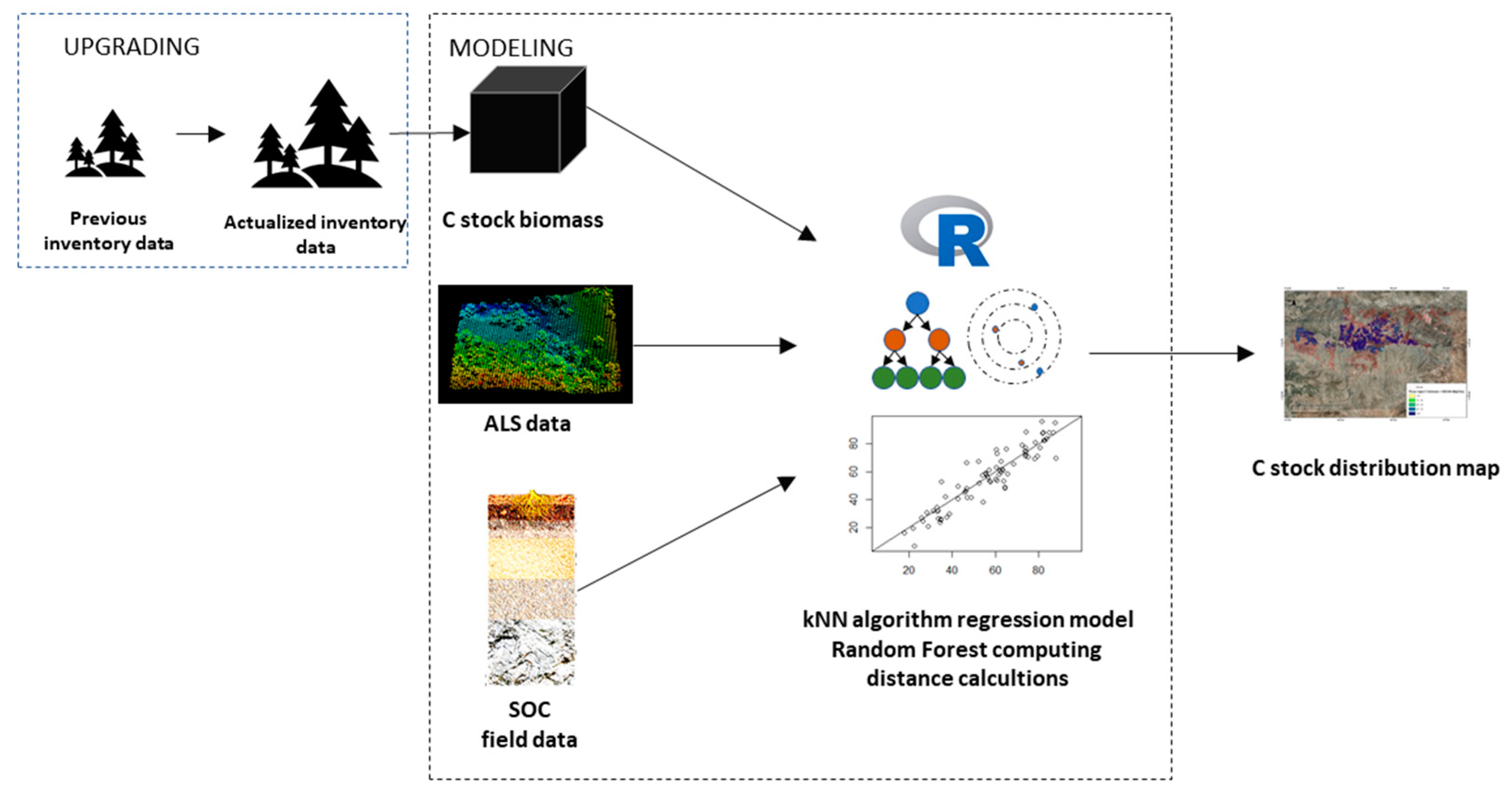

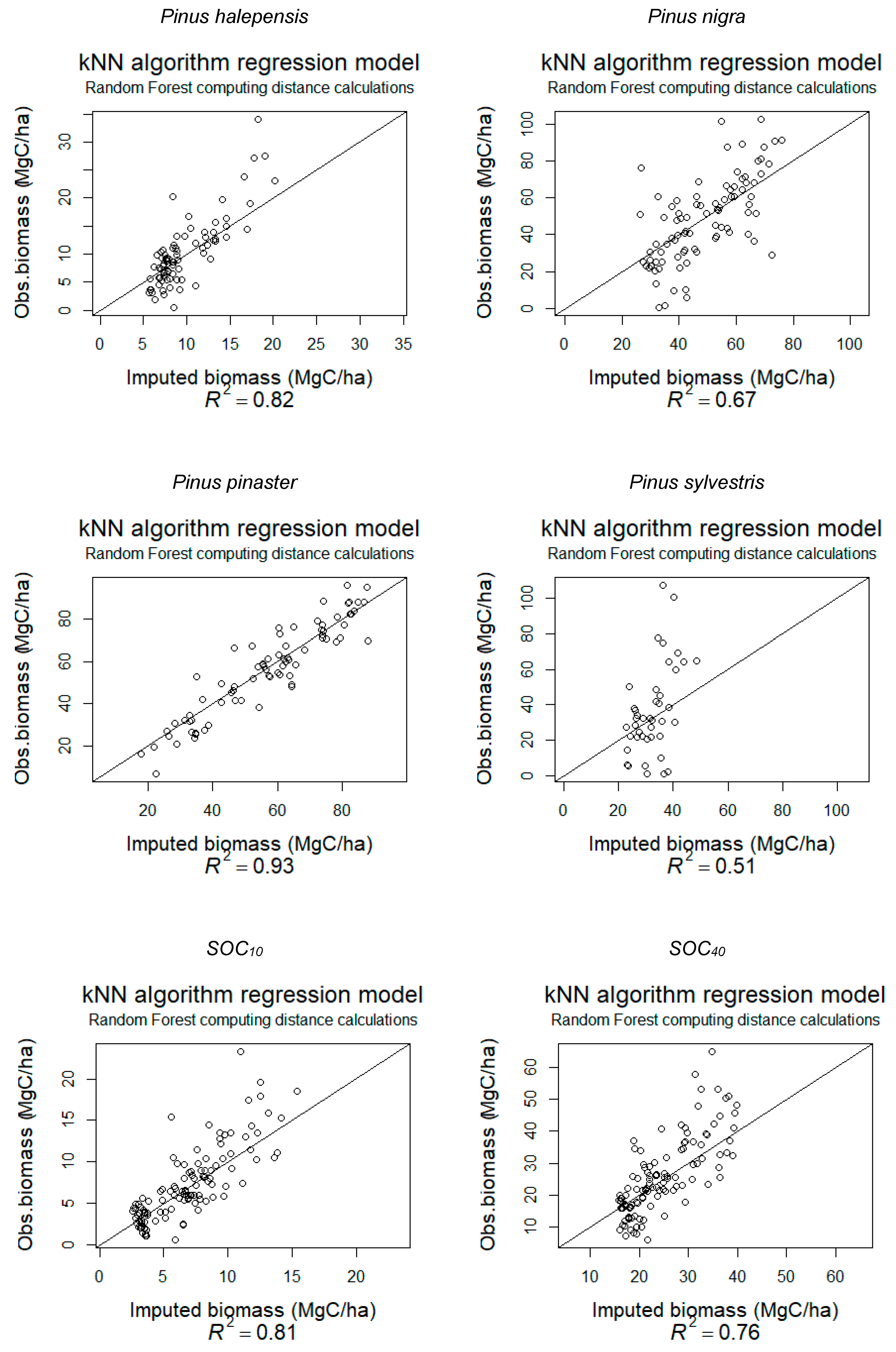

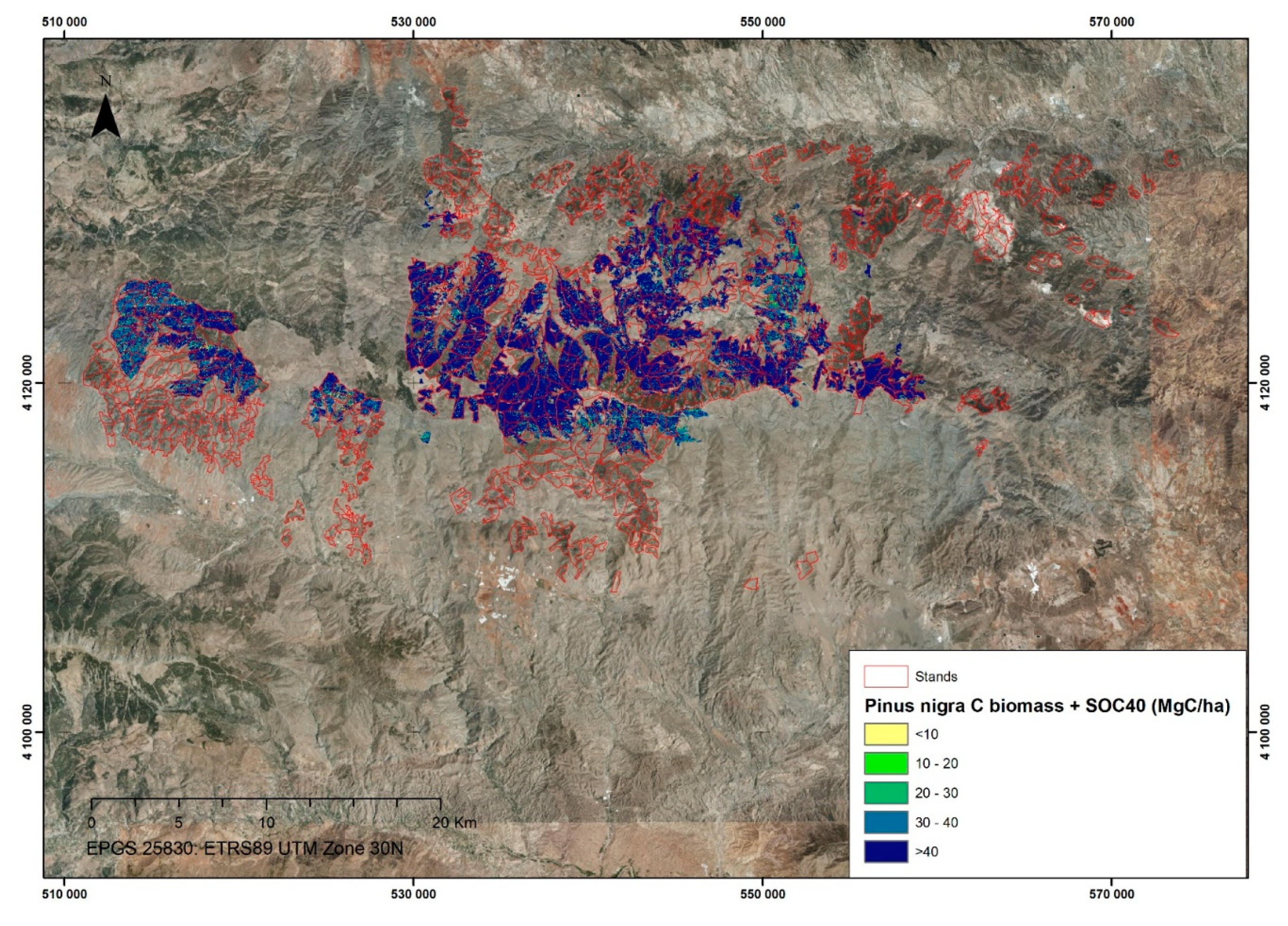
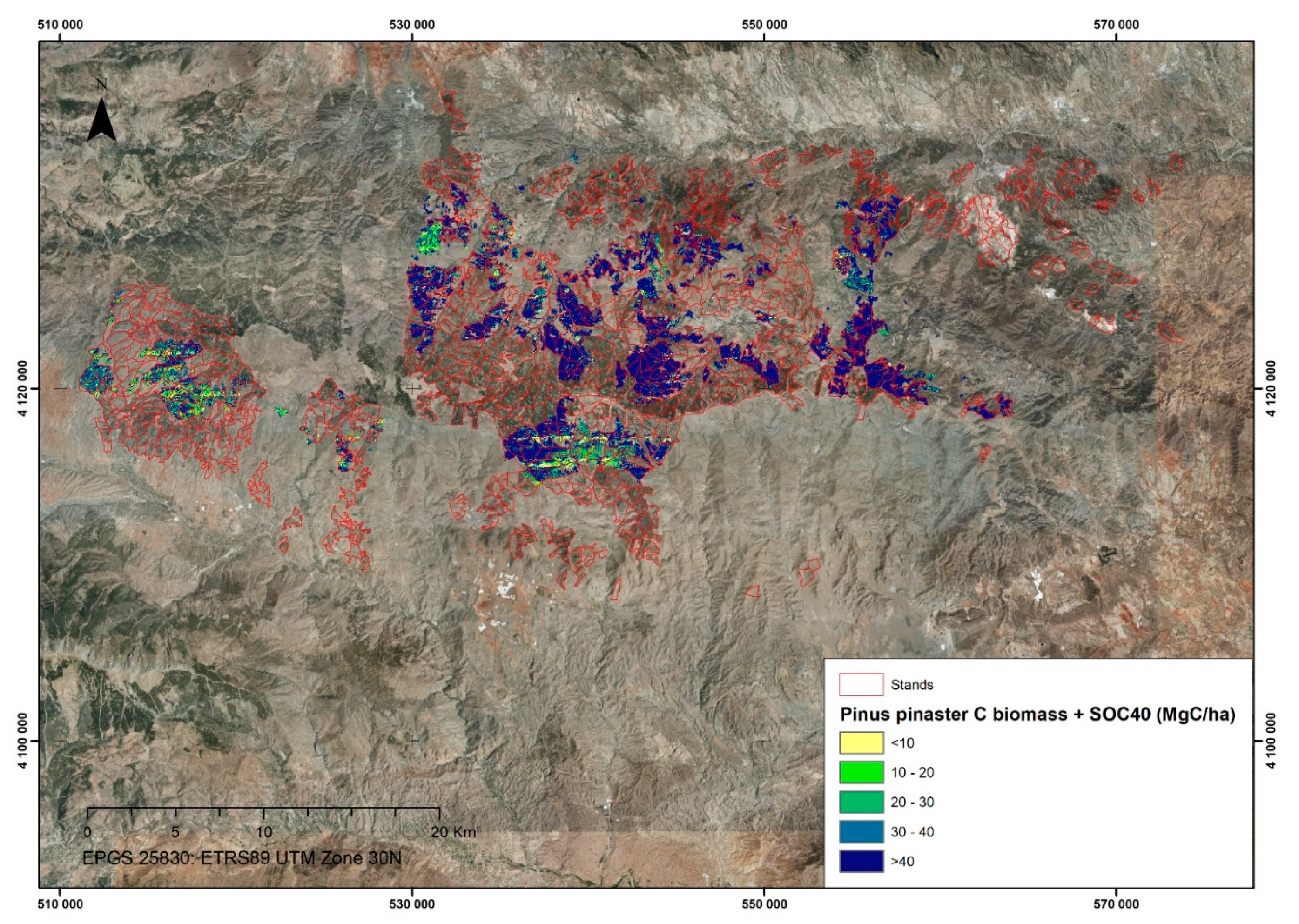
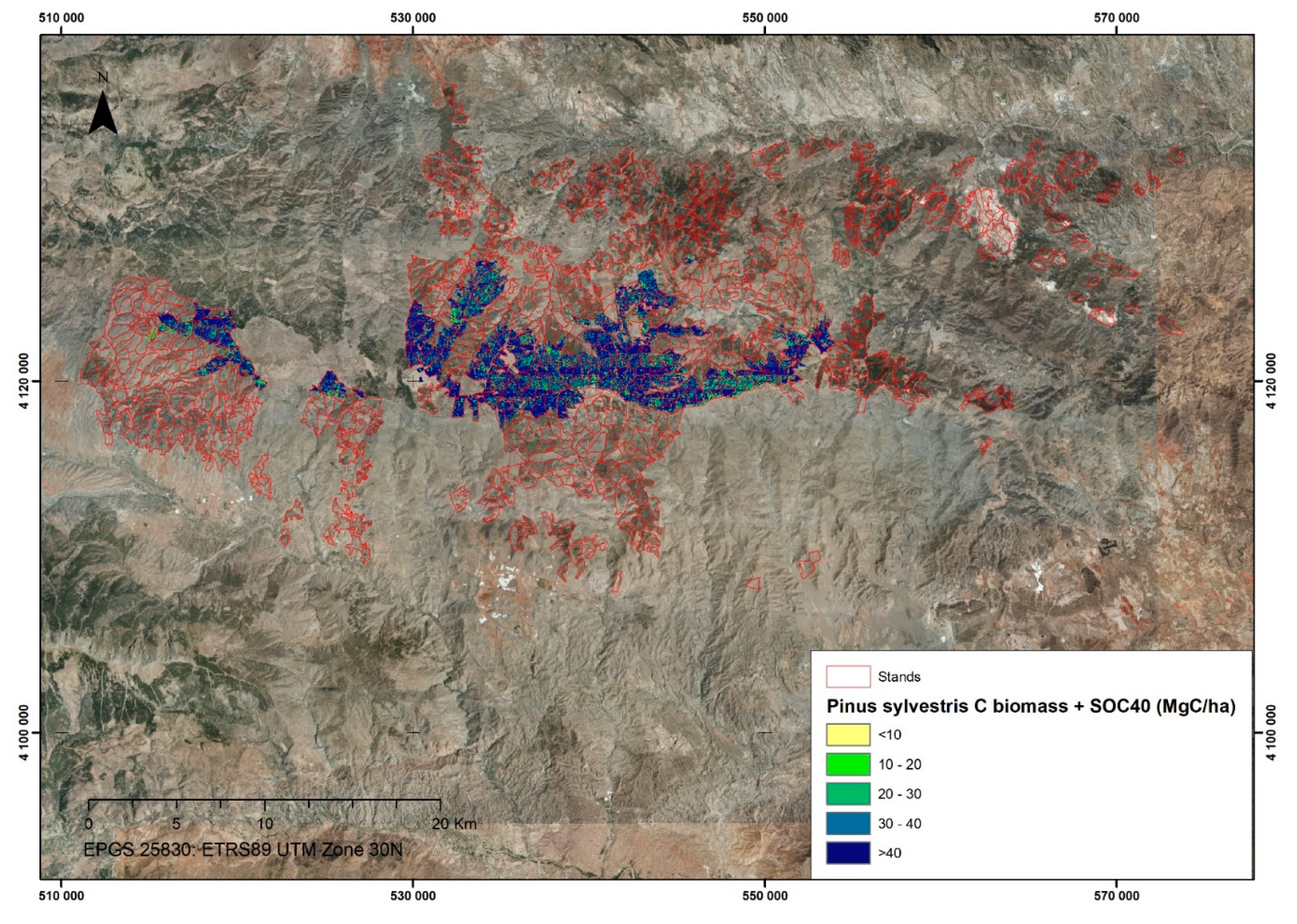
| Pinus Halepensis | Pinus Nigra | Pinus Sylvestris | Pinus Pinaster | |
|---|---|---|---|---|
| Surface area (ha) | 9118 | 7507 | 5900 | 5658 |
| Dg (cm) | 17.57 (0.26)b | 18.45 (0.16)b | 17.94 (0.32)b | 23.75 (0.21)a |
| BA (m2·ha−1) | 10.19 (0.33)c | 19.48 (0.50)b | 14.41 (1.09)c | 24.02 (0.62)a |
| N (trees·ha−1) | 419.32 (10.88)c | 732.35 (18.23)a | 605.04 (48.29)b | 536.81 (12.93)b |
| Ho (m) | 9.10 (0.12)c | 9.49 (0.11)b | 8.92 (0.18)c | 11.30 (0.09)a |
| Wt (Mg·ha−1) | 19.93 (0.75)c | 49.05 (1.40)a | 35.23 (2.65)b | 43.49 (1.19)a |
| SOC10 (Mg·ha−1) | 10.51 (0.57)a | 5.88 (0.69)b | 6.15 (0.58)b | 10.10 (0.75)a |
| SOC40 (Mg·ha−1) | 37.32 (2.24)a | 24.50 (1.49)a | 20.41 (2.18)a | 34.14 (2.29)a |
| Wt + SOC40 (Mg·ha−1) | 57.25 (1.41)c | 73.55 (1.29)a | 55.64 (2.01)b | 77.63 (2.12)a |
| Species | Stands | G (m2·ha−1) | Dq (cm) | Ho (m) | N (stems·ha−1) | SOC40 (Mg·ha−1) | Wt (Mg·ha−1) | |
|---|---|---|---|---|---|---|---|---|
| Pinus halepensis | <30 ha | 51 | 9.45 (5.52) | 16.57 (2.63) | 8.35 (1.48) | 455.04 (193.04) | 16.12 (7.81) | 8.16 (5.21) |
| 30–40 | 70 | 9.44 (5.72) | 16.47 (2.68) | 8.26 (1.51) | 445.01 (197.52) | 15.82 (7.72) | 8.52 (5.73) | |
| 40–50 | 72 | 8.99 (5.54) | 16.33 (2.68) | 8.19 (1.51) | 442.27 (193.96) | 15.45 (7.69) | 7.83 (5.10) | |
| 50–60 | 49 | 9.13 (5.61) | 16.54 (2.73) | 8.27 (1.54) | 443.61 (190.17) | 15.64 (7.94) | 8.02 (5.11) | |
| 60–70 | 41 | 9.62 (5.76) | 16.51 (2.71) | 8.27 (1.52) | 456.49 (198.88) | 15.52 (7.81) | 8.97 (6.03) | |
| 70–80 | 22 | 9.27 (5.60) | 16.42 (2.69) | 8.21 (1.51) | 435.41 (195.13) | 15.60 (7.45) | 7.73 (4.82) | |
| 80–90 | 18 | 10.70 (6.46) | 16.91 (2.77) | 8.46 (1.51) | 475.92 (200.53) | 15.06 (7.57) | 8.42 (5.49) | |
| 90–100 | 6 | 11.61 (7.70) | 17.51 (3.28) | 8.80 (1.80) | 459.59 (213.33) | 16.74 (7.82) | 9.21 (6.25) | |
| >100 | 1 | 16.89 (9.80) | 21.20 (4.05) | 10.72 (2.03) | 465.27 (210.04) | 22.04 (7.52) | 13.54 (9.54) | |
| Pinus nigra | <30 ha | 50 | 12.24 (7.78) | 17.78 (3.32) | 8.98 (1.79) | 503.48 (226.39) | 16.53 (8.09) | 43.32 (18.94) |
| 30–40 | 119 | 12.51 (7.52) | 17.64 (3.16) | 8.91 (1.69) | 517.09 (222.59) | 16.35 (8.03) | 43.05 (18.40) | |
| 40–50 | 110 | 11.43 (7.10) | 17.29 (3.07) | 8.72 (1.67) | 494.03 (212.43) | 15.99 (8.04) | 41.68 (18.41) | |
| 50–60 | 89 | 11.40 (6.89) | 17.29 (3.03) | 8.70 (1.65) | 501.75 (214.36) | 15.85 (7.87) | 40.43 (17.64) | |
| 60–70 | 72 | 11.35 (6.93) | 17.27 (3.04) | 8.67 (1.65) | 498.44 (209.10) | 15.89 (7.82) | 40.54 (17.76) | |
| 70–80 | 38 | 12.73 (7.68) | 17.63 (3.16) | 8.90 (1.67) | 521.27 (224.39) | 16.28 (7.93) | 41.41 (18.48) | |
| 80–90 | 22 | 13.13 (7.92) | 17.91 (3.37) | 9.02 (1.76) | 531.87 (228.82) | 16.34 (7.87) | 46.80 (19.15) | |
| 90–100 | 9 | 11.63 (7.27) | 17.47 (3.15) | 8.74 (1.69) | 504.17 (228.93) | 15.91 (7.75) | 41.01 (17.99) | |
| >100 | - | - | - | - | - | - | - | |
| Pinus pinaster | <30 ha | 50 | 12.23 (7.84) | 17.74 (3.34) | 8.95 (1.79) | 503.33 (230.11) | 16.86 (8.11) | 45.19 (20.33) |
| 30–40 | 100 | 12.27 (7.16) | 17.63 (3.12) | 8.88 (1.66) | 509.70 (219.97) | 16.58 (7.88) | 44.57 (19.22) | |
| 40–50 | 90 | 10.78 (6.66) | 17.05 (3.00) | 8.58 (1.64) | 482.24 (210.27) | 15.60 (7.93) | 40.40 (18.33) | |
| 50–60 | 73 | 10.79 (6.60) | 17.08 (2.95) | 8.57 (1.61) | 490.15 (211.98) | 15.59 (7.81) | 37.95 (17.82) | |
| 60–70 | 57 | 11.69 (7.16) | 17.39 (3.10) | 8.73 (1.65) | 505.11 (214.30) | 16.19 (7.76) | 42.34 (17.55) | |
| 70–80 | 33 | 10.25 (6.64) | 16.77 (2.90) | 8.41 (1.59) | 473.82 (218.81) | 15.46 (7.70) | 38.58 (19.03) | |
| 80–90 | 16 | 12.74 (8.07) | 18.01 (3.54) | 9.05 (1.84) | 510.64 (230.64) | 16.75 (8.10) | 49.45 (18.79) | |
| 90–100 | 10 | 11.68 (7.40) | 17.46 (3.23) | 8.76 (1.73) | 504.67 (229.02) | 15.97 (7.76) | 38.35 (19.82) | |
| >100 | - | - | - | - | - | - | - | |
| Pinus sylvestris | <30 ha | 26 | 13.67 (8.67) | 18.39 (3.61) | 9.32 (1.90) | 529.36 (239.54) | 17.48 (8.41) | 34.08 (23.10) |
| 30–40 | 68 | 14.18 (8.52) | 18.30 (3.45) | 9.27 (1.80) | 545.13 (233.82) | 17.33 (8.14) | 36.43 (22.79) | |
| 40–50 | 63 | 13.20 (8.31) | 17.98 (3.44) | 9.12 (1.84) | 520.31 (227.37) | 17.21 (8.22) | 35.14 (22.51) | |
| 50–60 | 56 | 12.25 (7.60) | 17.60 (3.20) | 8.90 (1.73) | 523.79 (226.17) | 16.25 (7.95) | 32.73 (20.58) | |
| 60–70 | 36 | 13.13 (7.92) | 17.84 (3.28) | 8.98 (1.71) | 532.18 (221.72) | 17.01 (7.70) | 34.65 (21.46) | |
| 70–80 | 23 | 14.21 (8.57) | 18.04 (3.34) | 9.13 (1.73) | 539.97 (228.88) | 16.82 (7.98) | 36.08 (22.71) | |
| 80–90 | 9 | 13.79 (8.39) | 18.25 (3.65) | 9.24 (1.88) | 551.74 (241.43) | 17.43 (8.27) | 39.03 (22.26) | |
| 90–100 | 4 | 14.69 (8.56) | 18.58 (3.50) | 9.34 (1.76) | 565.71 (251.33) | 17.32 (7.61) | 31.29 (17.74) | |
| >100 | - | - | - | - | - | - | - |
© 2019 by the authors. Licensee MDPI, Basel, Switzerland. This article is an open access article distributed under the terms and conditions of the Creative Commons Attribution (CC BY) license (http://creativecommons.org/licenses/by/4.0/).
Share and Cite
Navarrete-Poyatos, M.A.; Navarro-Cerrillo, R.M.; Lara-Gómez, M.A.; Duque-Lazo, J.; Varo, M.d.l.A.; Palacios Rodriguez, G. Assessment of the Carbon Stock in Pine Plantations in Southern Spain through ALS Data and K-Nearest Neighbor Algorithm Based Models. Geosciences 2019, 9, 442. https://doi.org/10.3390/geosciences9100442
Navarrete-Poyatos MA, Navarro-Cerrillo RM, Lara-Gómez MA, Duque-Lazo J, Varo MdlA, Palacios Rodriguez G. Assessment of the Carbon Stock in Pine Plantations in Southern Spain through ALS Data and K-Nearest Neighbor Algorithm Based Models. Geosciences. 2019; 9(10):442. https://doi.org/10.3390/geosciences9100442
Chicago/Turabian StyleNavarrete-Poyatos, Miguel A., Rafael M. Navarro-Cerrillo, Miguel A. Lara-Gómez, Joaquín Duque-Lazo, Maria de los Angeles Varo, and Guillermo Palacios Rodriguez. 2019. "Assessment of the Carbon Stock in Pine Plantations in Southern Spain through ALS Data and K-Nearest Neighbor Algorithm Based Models" Geosciences 9, no. 10: 442. https://doi.org/10.3390/geosciences9100442
APA StyleNavarrete-Poyatos, M. A., Navarro-Cerrillo, R. M., Lara-Gómez, M. A., Duque-Lazo, J., Varo, M. d. l. A., & Palacios Rodriguez, G. (2019). Assessment of the Carbon Stock in Pine Plantations in Southern Spain through ALS Data and K-Nearest Neighbor Algorithm Based Models. Geosciences, 9(10), 442. https://doi.org/10.3390/geosciences9100442







